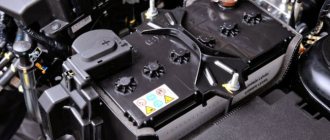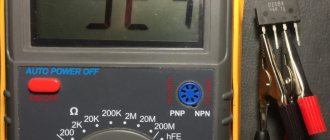Batteries are widely used in various areas of human life and activity. They can be found in smartphones, laptops, cars, and so on. Wherever a power source independent of the electrical circuit is required, batteries are used. Like any equipment, they need to be looked after, properly charged, stored, monitored for capacity, and so on.
Types of batteries
Why measure battery capacity?
The condition of the battery must be periodically monitored. This will significantly extend its service life, maintaining capacity and other parameters at the original level. Existing measuring instruments make it possible to quite accurately determine the current in the battery, voltage and determine the density of the electrolyte. If deviations in any of these parameters are detected, it is recommended to find out the cause and carry out the necessary maintenance measures.
There is currently no device for accurately determining battery capacity. The only method that gives relatively accurate results is to completely discharge it while simultaneously recording a large number of different parameters. However, this procedure is very lengthy, and rarely is anyone willing to spend time monitoring the capacity in this way. Other methods, like a special tester, provide only approximate results.
Note! The accuracy of determining various parameters largely depends on external factors: ambient temperature, humidity, and so on.
The most commonly used methods for determining capacity are:
- Performing a control discharge, which is a lengthy process and is used quite often;
- Monitoring the electrolyte density in the battery;
- Load fork;
- Capacity tester.
Device for monitoring the battery charge level
Types of testing equipment
To choose the right device to determine the health of the battery, you must first make sure what exactly causes it to malfunction. Among the typical malfunctions of the batteries of various devices are the following:
- Fast charging and discharging.
- Inability to start charging.
- Leakage current.
- Broken power circuits or damage to plates immersed in electrolyte.
- Insufficient density of the electrolytic fluid.
The best choice for identifying most of these faults is a universal battery tester, which covers most of the car enthusiast's needs. But some parameters, for example, electrolyte density, cannot be measured by electronic devices; for this, other, hydrostatic equipment is used. Therefore, all possible measuring devices can be like this:
- Multimeter - can detect open circuits, measure the strength of the current supplied, the resistance of the plates and contacts, and the voltage produced by the battery at the terminals.
- A load fork is a device that allows you to set the rate of battery discharge, thereby determining the degree of its wear.
- Capacity meters - show the current presence of charge in the battery. They are used to understand how dry the contacts are and whether the electrolyte needs to be replaced with fresh one.
- Hydrometers are hydrostatic meters of the density of an electrolytic liquid. They determine the need for recharging and can help in deciding whether to replace the fluid itself or the entire battery.
Each type of measuring instrument can have several purposes, depending on the model. For example, with a hydrometer, in addition to the specific gravity of the electrolyte, you can measure the indicators of antifreeze, so it is better to consider each of the types and its most useful models in more detail.
Household and industrial multimeters
When choosing a device for a specific task, you need to decide on its type. Multimeters, for example, come in both analog and digital varieties. The measurement method does not change; all differences are solely in the display on which the results are displayed.
Analog multimeters are meters with a needle that moves along a scale drawn in the background. Depending on the position of the switch, which is located immediately below the display, one of the scales is selected, and the required indicators are already obtained from it.
Today, such devices are of little use for everyday use, since the accuracy of the results is relatively low. Therefore, even if the household has an analog multimeter, it is better to replace it with a digital one. We recommend: How to properly change the electrolyte in a battery
The electronic subtype makes working with it much easier. Instead of arrows and scales, the value of the value selected by the switch is simply displayed on the screen. In this case, you can determine its value to tenths or even hundredths, which increases accuracy and gives a much more correct idea of the problem.
Each multimeter has additional functions that help in everyday life and repair of devices:
- "Squeaker." In reality, it is just a resistance difference meter, but it is used to detect electrical circuits and circuits that are in a short circuit state. At the same time, a squeak is heard, which gave this function its colloquial name.
- Thermocouple - special wires that can be connected to some models. Shows the current temperature on the surface to which it is applied.
Such features help a specialist or amateur quickly find out the cause of a breakdown or strange behavior of a device.
The most popular models of multimeters among radio amateurs and motorists are:
- DT-832 and its more modern modification DT-838. These are inexpensive and functional devices, which sometimes have a fairly high measurement error. But they remain indispensable for domestic use or in situations where more serious equipment is not at hand.
- Kemot KT30 - no longer uses AA batteries as power supply, but full-fledged nine-volt batteries of the Krona type. It has a low measurement threshold, the same price as the previous model, but boasts high accuracy - the error when using it does not exceed 1.2%.
- UNI-T UT 60 C is a more professional device. It has a built-in memory chip for storing a certain number of results of the latest measurements. Very durable body, resistant to any external influences. There is a display backlight for working in the dark.
- The Fluke 28-II is the ultimate tool for any professional. Expensive, reliable, accurate. Able to work in any temperature conditions, both cold and hot. Has built-in entry-level oscilloscope capabilities.
Of course, too expensive devices are not needed for everyday work; they can easily be replaced by a cheaper analogue. But if you often find yourself in unfavorable weather conditions, you should pay attention to those devices that are not afraid of the influence of the elements.
Hydrometers for electrolyte
The saturation of metal ions from the electrodes and free electrons greatly affects the performance of the car battery. To measure it, it is enough to use a hydrometer. Its action is based on the hydrostatic law, which postulates that the greater the density of a liquid, the more it tries to push an object floating in it to the surface.
We recommend: Causes and elimination of car battery sulfation
A flask with a sampling pipette on one side and a bulb creating negative pressure on the other serves as a reservoir for collecting such liquid.
The measuring element is a cylindrical glass float, which is equipped with a scale drawn on it. Measurements are taken using it as follows:
- The device is assembled, the meter is placed inside, and the bulb is put on.
- The pipette is immersed in the electrolyte.
- The pear collects a sufficient amount of liquid.
In this case, the floating part, under the influence of a small sinker in its lower part, is immersed in the liquid. Using the scale marked on it, you can find out the degree of discharge of the battery as a percentage. If the float is immersed too low, such a battery is considered completely unsuitable for operation. The contacts may be broken or the electrodes may be too oxidized.
Since acids act as electrolytes, you should take care of your own safety when working - wear thick rubber gloves, goggles and, if possible, a coarse linen apron. The respiratory tract is protected by a respirator. This helps to avoid the harmful effects of acid vapors on the lungs and nasopharynx. Therefore, this device for testing batteries should be used in a well-ventilated area.
Load forks
They are a combination of load resistance and voltmeter in the simplest configuration.
More advanced models can be equipped with an ammeter, a capacitance meter, and even attachments for checking ESR in capacitors.
Structurally, they look like a rectangular metal case with a handle-holder and a wire with a large cross-sectional area with a clamp at the end. The building contains:
- Load spirals.
- A cylindrical rod extending outwards.
- The voltmeter dial is mainly analog - with a scale and a moving needle.
The voltmeter contacts are connected to a rod (minus) and a wire (plus). Using a load fork as a battery tester is simple. The verification takes place in two stages:
- Terminal voltage measurements without the participation of the load from the spirals. It is carried out only 5-7 hours after the car has been completely turned off or after the same period after the end of recharging. A terminal is connected to the positive contact, and you need to touch the negative one with a rod. The voltage readings obtained as a result of measurements are recorded.
- Test with applied load. After submitting it, you need to do the same manipulations, but do not keep the chain closed for more than five seconds. In addition, there is a possibility of a spark jumping between the contacts, so do not worry about this.
The indicators at the second stage should not differ greatly from the battery’s passport data. If they differ from it to a lesser extent, such a battery can be safely replaced.
Universal instruments and capacity meters
These are tools for determining one of the most important characteristics that directly affects the further use of the battery.
Any battery has a nameplate capacity, which is measured in ampere-hours. We recommend: In what order to connect the battery to the car
Over time, its value drops and such a device cannot maintain the charge level for the usual time. In this case, problems arise with the use of the product that is powered by a current source.
The passport capacity is always known, it is reported by the manufacturer and applied to a sticker that clings to the side wall. Therefore, to find its current value, you need to use one of the following devices:
- Pendant is a tester for testing domestically produced batteries. All measurements are saved in the permanent memory of the device. It can not only show the capacity, but also the voltage produced by the current source. During operation, it sends a short pulse, and based on the speed of receiving a response, it gives readings.
- Fluke is the most versatile tool available. Measures voltage, current, internal resistance of elements and capacitance. Can be used for temperature measurements.
- Skat-T Auto is a good device for use with twelve-volt batteries. Has limitations on battery capacity, will not work with those models that hold more than 120 amp-hours. All measurements are carried out within fifteen seconds.
It is worth remembering that each of these models has different measurement ranges. You need to carefully select them before use, since an incorrectly specified order of magnitude can negatively affect the results obtained.
Implementation of a control discharge
IS 10 - a device for measuring ground resistance
To determine the degree of charge, a controlled discharge procedure is often used to record a large number of different parameters. It is believed that this method allows you to obtain the most reliable results about the performance of the battery.
Important! This method should be carried out only in laboratory conditions and in compliance with all rules. Otherwise, the battery may stop working.
This method involves first fully charging the battery, then connecting it to a circuit with constant consumption and waiting for it to completely discharge. During operation, the discharge and voltage are measured every hour, the value of the parameter of interest is calculated using a special formula: the current strength is multiplied by the time of complete discharge. The inconvenience of this method is its duration (it may take up to a day to completely discharge the battery).
Multimeters
To begin with, it is important to focus on the fact that there are household and industrial diagnostic multimeters.
This is a fairly universal tester that allows you to find out a lot of useful information about the battery in your car.
The most popular tester. The main capabilities that multimeters have for assessing the condition of car batteries include:
- determining the presence of an open circuit;
- current measurement;
- resistance measurements;
- voltage parameters.
Multimeters themselves are either analog or digital. They differ only in the display on which information is displayed. Plus, the accuracy of digital models is slightly higher.
Analog devices are presented in the form of a tester with a pointer screen, where a measurement scale is located under the pointer. Depending on what mode the multimeter is operating in, the arrow moves to the desired scale when switching. But now analog multimeters are almost never used. This is due to their accuracy and the emergence of more advanced electronic models.
Working with a digital device is much easier. The display is presented in the form of an electronic display, where the displayed parameters change depending on the mode. The advantage of an electronic type multimeter is that it reads tenths and hundredths of the measured values. Sometimes even a deviation of a couple of tenths indicates a malfunction, but an analog device will not notice them.
The functionality of multimeters is varied. But usually they allow you to measure voltage, current, resistance, etc. You just need to switch the device to the desired mode and set the measurement interval. Plus, the devices are complemented by some options in the form of tweeters, backlight, thermocouple, color display, etc.
The more functions, the more versatile the device will be. This will allow you to find out a complete set of information using one device.
But in the case of battery maintenance, the multimeter does not have some capabilities.
If you need a tester designed to measure the capacity parameters of a car battery, then a multimeter is unlikely to help. Here it is worth using other devices.
Using the load fork
Force measuring device
This device is used to check the condition and performance of the battery. A controlled load is applied to it (there is a resistor in the device for this purpose), and the voltage is determined (two probes are used, which are connected to the plus and minus of the battery). In practice, you can find different types of devices:
- Equipped with a digital or analog voltmeter;
- With a simple circuit with one element supplying the load;
- With multiple load spirals;
- With current measuring equipment;
- With a complex circuit to determine the voltage in specific battery banks.
Load fork
The result of its application is the voltage value. To find out the charge level, you should use a special table.
Correspondence of voltage and state of charge when using a load plug
| Voltage value | Approximate capacity,% |
| 12,6-12,9 | 100 |
| 12,3-12,6 | 75 |
| 12,1-12,3 | 50 |
| 11,8-12,1 | 25 |
| 11,5-11,8 | 0 |
Determination of battery capacity. Physical meaning
The capacity of the battery determines the amount of time during which the battery can supply energy to the payload.
Battery capacity is measured in ampere-hours. The physical unit itself shows that the battery capacity is the product of the battery discharge current (in amperes) and the battery discharge time (in hours). Battery capacity is a physical quantity that, together with battery voltage, determines the amount of energy that a fully charged battery can provide. The concepts of battery capacity and battery charge (charge) should not be confused. Capacity determines the potential of the battery, that is, the amount of time during which the battery can supply power to the load if the battery is fully charged. The actual capacity of the battery is determined by several factors: the magnitude of the applied load, the temperature of the battery. The more load is applied, the faster the battery discharges. The lower the temperature, the less capacity the battery has. Battery capacity is a value that depends on the measurement method and conditions, so it must be considered in accordance with the technical documentation for the battery. Typically, the manufacturer specifies a long-term method for discharging the battery (within 20 hours) at room temperature (20 degrees).
Electrolyte density control
Battery charge indicator
You can also use a hydrometer (measures the density of the electrolyte) to determine the degree of charge as a percentage of the initial value. When measuring using this method, you will also need a special table.
Correspondence between electrolyte density and amount of charge
| Density | Capacity,% |
| 1,27-1,29 | 100 |
| 1,23-1,25 | 50-70 |
| 1,11-1,13 | 0 |
This method provides an approximate result; the exact value of the parameter cannot be determined using it. It is distinguished by its comparative simplicity - it is enough to provide access to the device for measuring the battery capacity in all jars (open them), then draw liquid into the hydrometer and write down the resulting value, which is then compared with the table.
Hydrometer
The performance of the battery largely depends on the state of the electrolyte. To take measurements, electrolyte hydrometers are used, the use of which is not difficult.
The operation of a hydrometer is based on the hydrostatic law. The higher the density of a liquid, the more it will try to push objects in it to the surface.
The hydrometer is presented in a fairly simple form. This is a flask with a pipette for collecting liquid and a bulb that creates pressure. A cylindrical glass float with a printed scale is used as a meter.
To take measurements you need:
- assemble the device according to the instructions;
- immerse the pipette in the electrolyte;
- use a bulb to collect liquid;
- Using the scale as a guide, read the values obtained.
A normal density for an electrolyte is considered to be in the range of 1.25–1.28 g/cm³. In case of deviations from the norm, it is necessary to add electrolyte or add a certain amount of distilled water.
In relation to batteries, the peculiarity of the hydrometer is that it can only be used when working with serviceable batteries. They allow you to open the cans and access the electrolyte. In the case of maintenance-free batteries, there is practically no need for a hydrometer. Unless it will be possible to check whether the declared density of the purchased electrolyte corresponds to reality.
Using special devices
The measurement method used in the load fork has been improved in specialized devices of the “Pendant” brand. They were developed to test the condition and evaluate various parameters of lead-acid batteries. These devices allow you to determine the voltage value and charge level. All information is stored in the memory of the device, which is also portable.
Monitoring battery parameters using the “Pendant” device
The use of these devices has certain features:
- They can only be used on a fully charged battery, since they are powered by a battery, the condition of which is checked.
- Before use, calibration should be carried out (this process is described in the operating instructions). Otherwise, you may receive incorrect data.
Additional Information. In addition to compact dimensions, the advantages of the “Pendant” devices are also the use of a unique measurement technique, as well as the presence of pliers-clamps that reliably fix the wires and ensure the accuracy of the readings.
Thus, determining the battery charge level is a rather labor-intensive process, but it is recommended to carry it out at certain intervals to ensure a long service life. For this, you can also use various devices that, although they do not allow you to accurately determine this parameter, provide the opportunity to assess the general condition of the battery.
Universal devices and capacity testers
If you need to check the capacity, additionally find out the voltage parameters and other values, in this case a universal tester for car battery diagnostics will help.
Each battery has certain capacity parameters. They are indicated directly on the case in large numbers. But this is the ideal capacity that the battery receives from the factory. During long-term storage or operation, these parameters gradually (and sometimes quite quickly) decrease.
To find out what the real battery capacity is now, you should use an automatic tester.
There are several devices that are positioned as universal devices and capacity meters in batteries.
- Skat T Auto . An excellent device that is designed to work with 12-volt batteries. But there are restrictions on the tested capacity. If the capacity is more than 120 Ah, diagnostics cannot be carried out using this device. It takes literally 15 seconds to evaluate the current values.
- Fluke . It is considered the most versatile device in its category. With its help, you can evaluate the parameters of capacitance, internal resistance, current and voltage. Also relevant if you need to check temperature readings.
- Pendant . Domestic product. The read data is stored in the gadget’s memory. Able to check capacity, current and voltage. During testing, the device sends a pulse. Based on how quickly the tester receives a return signal, the battery values are determined.
In fact, such a universal device can replace several separate devices.
Which of the above will be useful to you depends on your specific situation.
Some people don’t do diagnostics at all, and therefore entrust all the work to car service specialists. Others try to contact a service station as little as possible, preferring to do everything themselves.
Battery repair and maintenance is not the most difficult task. This is especially true for maintenance-free batteries, where you only need to check the voltage and capacity and periodically charge the battery.
If the battery is serviceable, then the presence of a hydrometer will become a prerequisite for long-term and trouble-free operation. It is enough to immerse the device in a jar, and the result will be known. This helps to understand exactly whether it is necessary to add electrolyte, or in this situation it is correct to simply use distilled water.
The most universal and necessary tester for all motorists can rightly be called a multimeter. It will be useful not only when working with the battery, but also in case of any problems with the electrical and electronics in the car. This is much more convenient than buying a voltmeter, ammeter, etc. separately.
Sliding tester
This tester has the simplest design imaginable, which is fully reflected in its extremely low cost. One of the contact pads here is made in the form of a folding leg, which allows you to install batteries and accumulators of AAA, AA, CR2032, as well as 18650 and several other most popular formats. For Krona batteries, there are 2 separate contacts on the opposite side. The level of remaining charge is displayed on an analog scale, where the green and yellow zones indicate the battery’s expiration date, and the large red sector indicates the need to replace them with new ones or charge them.
$3.13 | Buy
Top
What is the capacity of a battery or accumulator
All batteries are usually decorated with inscriptions like 55, 70 Ah or 1800mAh. This designation indicates that the capacity of this battery is, respectively, 55 Amperes or fractions of Amperes per hour, only translated into English - A/hour. It must be distinguished from another parameter - voltage, which is written in Volts.
The Ah indicator shows how long the battery will work for an hour at a load of 60 Amps and a voltage of 12.7V. In other words, capacity is the amount of energy that a battery can hold.
And if there is less than 60A load, the battery will last longer than 60 minutes.
Tester with LCD screen
The structure of this device for determining charge involves installing batteries on its side, by fixing them between the contacts using a sliding slider. To display charge information, the device uses a tiny LCD screen that displays values in volts. A cheat sheet consisting of control values is printed on the back of the case in the form of an indelible microrelief. The tester is compatible with batteries with voltages from 1.5 to 9 volts. Contacts for checking elements of the “Crown” type are located on the opposite part of the housing.
$3.52 | Buy
Top
Digital battery tester
In general, this tester resembles the previous one, but has a number of significant differences from it. The body of the device turned out to be more voluminous, which made it possible to place an informative screen on it, which displays not only the voltage scale, but also digital and percentage values. Additional information on charge levels was included on a colored sticker. A sliding slider with contacts allows you to check the vast majority of formats of current battery types. The device itself requires 2 pinky batteries to operate.
$6.32 | Buy
Top
Measuring instruments
Measuring capacitance and other important parameters can be carried out with various instruments:
- Manual measurement to full discharge and counting;
- Multimeter (ammeter);
- Specialized devices.
Both with the help of multimeters and with the help of special means the capacitance characteristics are measured thanks to the test charge of the battery. To do this, the device is fully charged, which is checked by measuring the voltage and density of the electrolytes. After this, a load whose power is known is connected, and the exact time at which the discharge begins is noted. When the voltage drops to 50% of the original maximum, the load is turned off and the capacitance is calculated. Discharging the battery completely is dangerous.
Load fork diagram
Measuring the capacitive parameters of a battery yourself is quite simple. They will not be the most accurate, since the process did not use special equipment and the same current consumption as possible.











